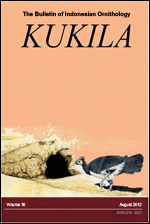Breeding, Plumages and Vocalisations of the Pied Bush Chat <em>Saxicola caprata pyrrhonotus</em> on Kisar Island, Lesser Sundas
 Abstract views: 287
,
Abstract views: 287
,
 PDF downloads: 55
PDF downloads: 55
Abstract
The Pied Bush Chat Saxicola caprata occurs widely in South, South-east Asia, and the Papuan region with 16 subspecies recognised including pyrrhonotus in the Timor region. Observations on the small island of Kisar, 25 km north of eastern Timor-Leste, revealed that the females differed from those of Timor, and may represent an undescribed subspecies. Females on Kisar had a cream-coloured throat with grey-brown streaks, and the breast and belly were streaked with dark brown, whereas those on Timor and Wetar have these parts plain light brown or rufous. The song of the Kisar bird also differed from those on Timor, but there is substantial variation in vocalisations among individuals, making quantitative inter-island comparisons difficult. Breeding was evident in October and the fledglings were found to be sexually-dimorphic as reported elsewhere for this species.
Downloads
Download data is not yet available.
How to Cite
Trainor, C. R. (1). Breeding, Plumages and Vocalisations of the Pied Bush Chat <em>Saxicola caprata pyrrhonotus</em> on Kisar Island, Lesser Sundas. KUKILA, 16, 32-38. Retrieved from https://kukila.org/index.php/KKL/article/view/393
Issue
Section
Full Articles
Authors who publish with this journal agree to the following terms:
- Authors retain copyright and grant the journal right of first publication with the work simultaneously licensed under a Creative Commons Attribution License that allows others to share the work with an acknowledgement of the work's authorship and initial publication in this journal.
- Authors are able to enter into separate, additional contractual arrangements for the non-exclusive distribution of the journal's published version of the work (e.g., post it to an institutional repository or publish it in a book), with an acknowledgement of its initial publication in this journal.
- Authors are permitted and encouraged to post their work online (e.g., in institutional repositories or on their website) prior to and during the submission process, as it can lead to productive exchanges, as well as earlier and greater citation of published work (See The Effect of Open Access).




